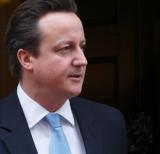New Delhi, Feb 17: Arriving here within days of exposure of the Rs 3,600-crore VVIP helicopters scam involving Anglo-Italian firm AgustaWestland, UK Prime Minister David Cameron is likely to be pressed for more information in this regard during his meetings with the leadership on Tuesday.
The visit also comes in the wake of India taking steps to scrap the contract after Italian investigators probed allegations that aerospace group Finmeccanica, the parent company of AgustaWestland, had broken the law by paying bribes to foreign officials.
The helicopters, three of which have already been delivered, are manufactured in southwest England.
India has already issued a note verbale and met with UK Foreign Office officials to get information and assistance in probing the allegations of corruption in the deal, an official spokesperson in the Ministry of External Affairs said.
Noting that the UK has provided an interim response, the spokesperson also said, "Nobody is ever satisfied with an interim response. Everybody would want a full-fledged response. So, I mean it is pretty obvious that we would like a full-fledged response."
Westland used to be a UK firm and was taken over by Italian defence giant Finmeccanica.
Cameron, accompanied by a large official business delegation, will hold comprehensive talks with Prime Minister Manmohan Singh on a wide range of bilateral, regional and international issues.
Apart from the defence deal, other major issues expected to figure during Cameron's three-day visit would include the Rs 12,000-crore Vodafone tax dues matter and the UK hosting a meeting between the Pakistan and Afghanistan Presidents.
While the Vodafone issue also figured during the recent visit of Finance Minister P Chidambaram to the UK, details of the UK-Pak-Afghan trilateral meet was being "finely studied" by New Delhi.
According to reports from the UK, Cameron also wants to use the trip to correct any misunderstandings about his government's move to bring immigration numbers under control amid concerns that young Indians could be deterred from applying to study in Britain.
Cameron's trip also comes close on the heels of a visit by French President Francois Hollande here to drum up trade, underlining the growing importance of the Indian economy.
Ahead of the visit, the UK Prime Minister said he wanted the relationship between Britain and India to be "one of the great partnerships of the 21st century".
Before landing here on February 19, Cameron along with his delegation would be spending a night in Mumbai where he will attend a business meet and place a wreath on police memorial.
Cameron's India visit is being billed in the UK as the biggest trade trip ever organised by his office.
India and the UK have vibrant economic ties and the two- way trade rose to about USD 16.157 billion in 2011-12 from USD 12.56 billion in 2010-11.
Total British FDI in India, as of October 2012 from April 2000, was about USD 17.08 billion, which is about 9 per cent of the total foreign direct investment in India. There are about 700 Indian companies which have operations in the UK out of which over 70 are listed on London Stock Exchange.





Comments
Add new comment